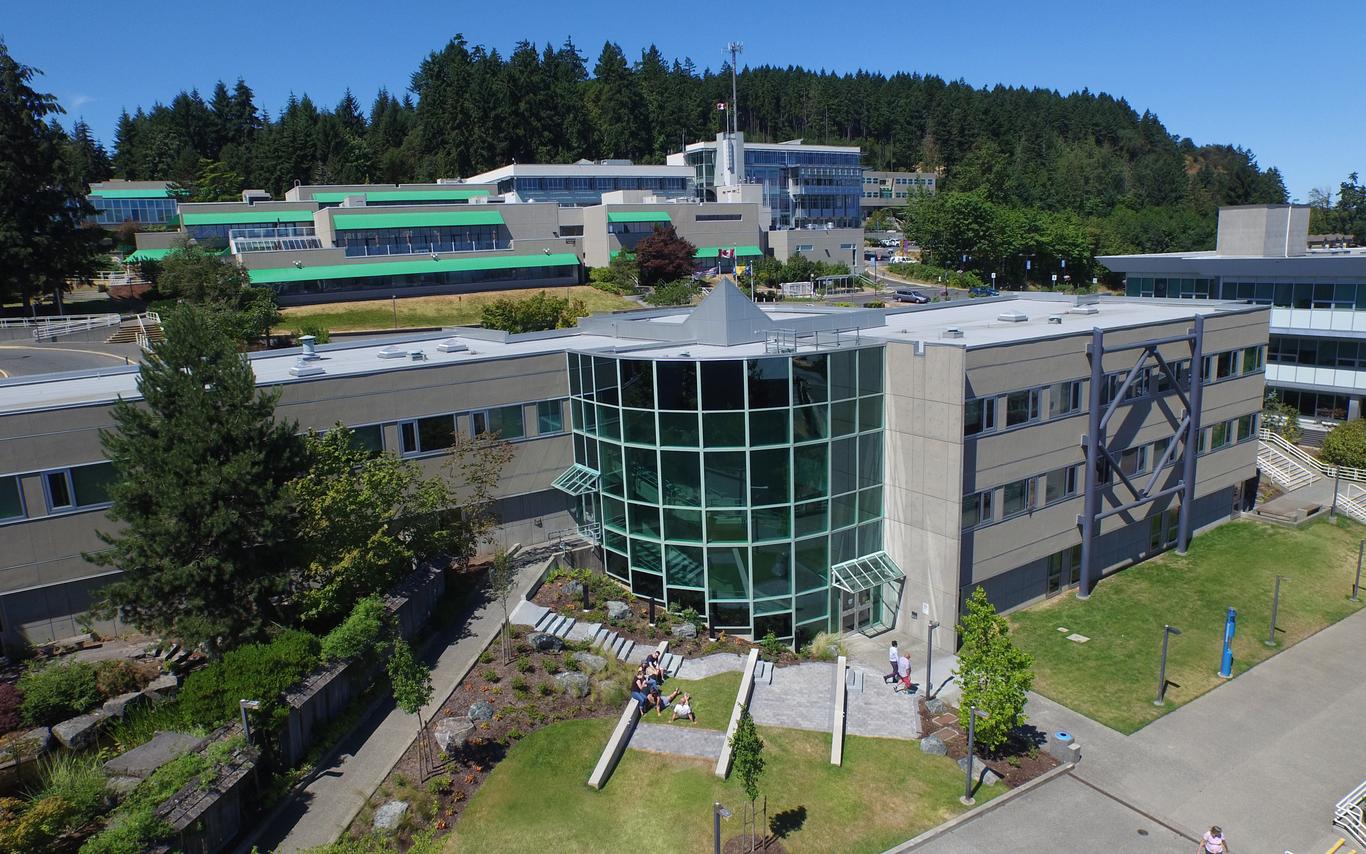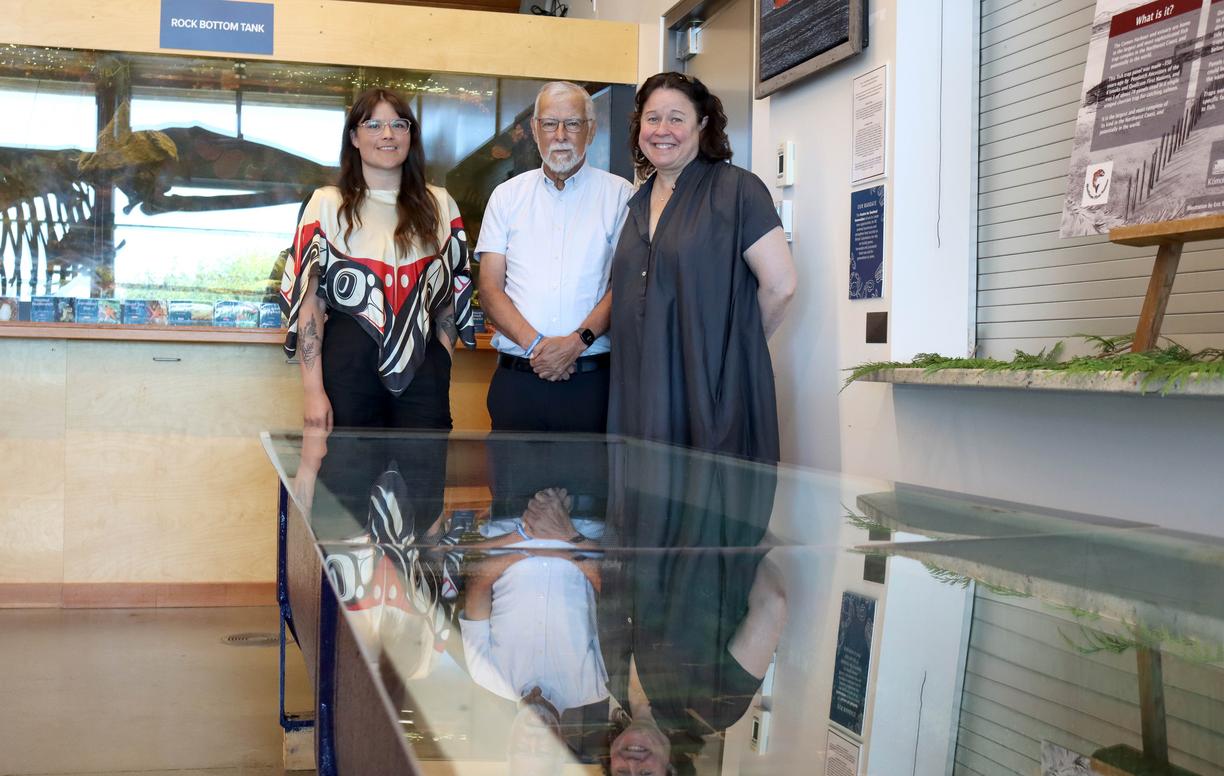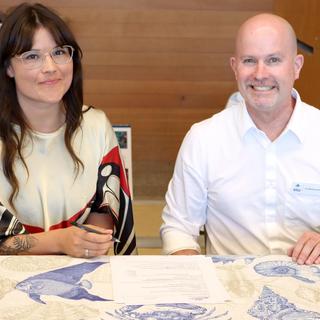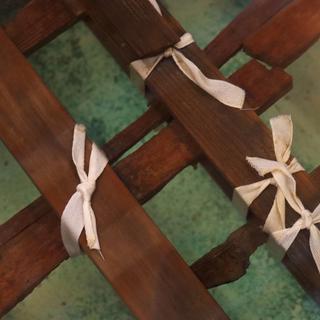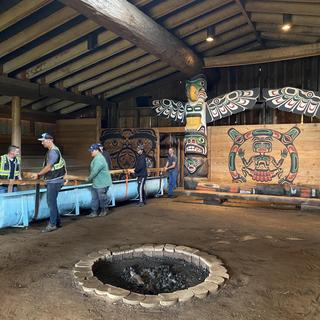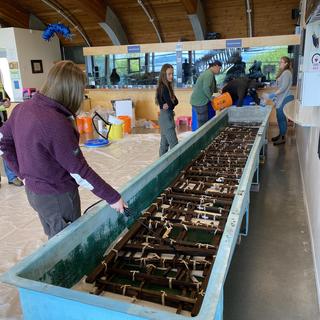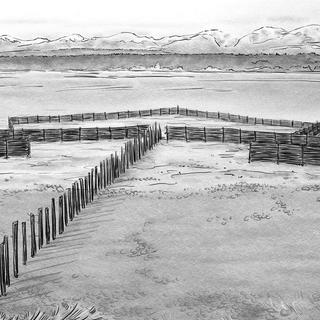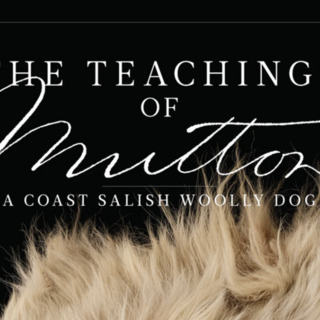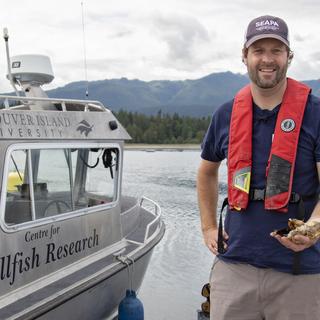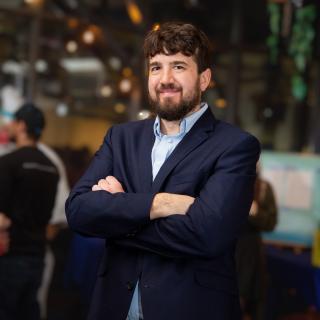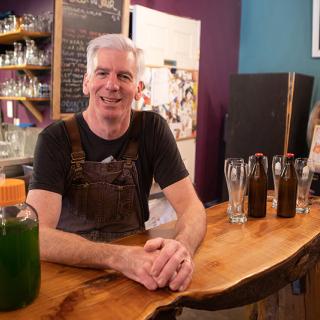From left to right, Candace Newman, Elected Councillor for K’ómoks First Nation, Michael Recalma, Elected Chief Councillor for Qualicum First Nation, and Dr. Deborah Saucier, VIU President and Vice-Chancellor, stand next to the tank holding the 550-year-old fish trap panel.
A significant Pentlatch cultural Belonging unearthed by K’ómoks First Nation and archaeological collaborators is on public display for the next six months at Vancouver Island University’s (VIU’s) Deep Bay Marine Field Station.
At 550 years old, the fish trap panel is an incredible and enduring example of Pentlatch cultural ingenuity. It is the largest and most complete of its kind on the Northwest Coast, and potentially in the world. It measures roughly six metres long and 70 cm wide, with 13 long laths and nine vertical support laths, bound together with cordage made from plant fibres.
The panel was made by Pentlatch Ancestors of the K’ómoks and Qualicum First Nations and was one of about 78 panels used in a single winged chevron trap for catching salmon. The panel provides a window into the sophisticated knowledge and unique cultural innovations of the Pentlatch peoples.
This fish trap panel revealed itself to the community in 2017 in the K’ómoks Harbour, on the beach in front of K’ómoks Reserve #1. Knowing how quickly it would deteriorate when exposed to air, a team of K’ómoks Guardians, community members and archaeologists mobilized to salvage the panel. Since then, it has required painstaking care and conservation. It has now been moved to the Deep Bay Marine Field Station, where it will be on display for the next six months as a living exhibit while K’ómoks representatives and collaborators complete its conservation.
The panel can be viewed at the VIU Deep Bay Marine Field Station, 370 Crome Point Road, in Bowser, during regular business hours.
Media Contacts
K’ómoks First Nation
Nicole Gavac, Communications Manager
250-339-4545
Qualicum First Nation
Michael Recalma, Elected Chief Councillor
250-757-9337
Vancouver Island University
Jenn McGarrigle, External Communications Manager
250-619-6860
Photo captions:
Photo 1 (above): From left to right, Candace Newman, Elected Councillor for K’ómoks First Nation, Michael Recalma, Elected Chief Councillor for Qualicum First Nation, and Dr. Deborah Saucier, VIU President and Vice-Chancellor, stand next to the tank holding the 550-year-old fish trap panel.
Photo 2: Candace Newman, Elected Councillor for K’ómoks First Nation, and Carl Butterworth, Director of Research Operations and Industry Engagement at VIU, sign the loan agreement.
Photo 3: A close-up view of the laths and supports submerged in the water and PEG solution.
Photo 4: K’ómoks First Nation Guardians, Archaeologists, Royal BC Museum and Coastal Transportation Solutions collaborators move the panel out of the KFN Big House to its new temporary home at the VIU Deep Bay Marine Field Station.
Photo 5: KFN Archaeology and Guardian staff installing the panel in Deep Bay with Royal BC Museum and Deep Bay Marine Field Station collaborators.
Illustration: Artistic representation of a winged chevron fish trap; illustrationby Eric Simons in Tidal Belongings: First Nations-driven Archaeology, Connaughton et al. 2022.
Quotes
“The fish trap panel is an incredible example of our Ancestors’ technological sophistication and ingenuity. It represents the strength of our cultures, and it continues to be a point of pride for our Nation.
“Preserving the panel has been a massive collaborative effort since 2017 between K’ómoks members, Guardians, archaeologists, Royal BC Museum Archaeologists and Conservators, and now the Deep Bay Marine Field Station. Many community partners have volunteered their time and resources to help document, preserve and safeguard the panel.
“We are proud of our cultural heritage and we’re taking the lead in protecting and preserving it. We’re also excited to share our cultural heritage from our own perspective, in our own words.
“Our cultural heritage sites are under threat from the fast rate of development in the Comox Valley, so we are also investing in protecting our cultural heritage by implementing our own archaeological permitting system.”
“Pentlatch (and, by 1850, other K’ómoks groups’) Ancestors used elaborate fish traps to target herring and salmon in the K’ómoks Harbour, and also at Goose Spit and Saratoga Beach. They built the traps perpendicularly to the shore, with a ‘leader’ line directing fish into enclosures in the deeper water where they would be trapped as the tide went out. Panels like this one were like fences that could be removed to release fish if too many were trapped for a sustainable harvest, or when they weren’t being used.
“The long laths were made from Western Hemlock and the short laths were made from Sitka Spruce. The cordage was made from roots or small tree limbs (withies).”
“We’ve been collaborating with archaeologists, the Royal BC Museum, and community partners like Coastal Transportation Solutions to preserve and move the panel, which is an elaborate and delicate process.
“KFN is taking the lead in documenting and preserving their cultural heritage, and we’ve recently extended the oldest radiocarbon date of the fish trap stakes in the harbour from 1,350 to 1,450 years ago (the year 500).”
“There’s a misconception that the fish traps were “discovered” by archaeologists because they were covered in sediment from at least 1886 (when well-known ethnographer Franz Boas visited) until 1946 when the K’ómoks community witnessed the stakes ‘pop up’ from the riverbank during an earthquake.
“But K’ómoks Elders have always known about them. In 1936, my Säsitla ancestor George Mitchell talked about the Pentlatch ‘fish mazes’ in an interview with an ethnographer. He said the traps were owned and maintained by specific families, who had priority access to fish.
“As a kid growing up in the ’80s and ’90s, my dad would tell us not to touch the fish weirs, because they had been there for a long time.”
“The Guardians are the eyes and ears of the land and sea, from the tops of the mountains to the bottom of the ocean and everything in between. We’re responsible for taking care of the land and sea, including the environment, wildlife and our cultural heritage.
“We were the first ones called when the panel was identified in 2017. We worked with a team of archaeologists to excavate the panel and we’ve been taking care of it since.”
“The trap shows how efficient we were at fishing for our communities even back in the old days or in the beginning of time. It depicts the tie between us – K’ómoks First Nation and Qualicum First Nation. We’re tied in so many ways. The land is shared, it always has been, always will be. In Deep Bay, we also have stone traps that are close to this facility, and they are thousands of years old. Again, it shows a different way of fishing and how innovative we were to utilize nature and use the resources we had to trap the fish we needed.”
“We are honoured to have been invited to participate in this important community-led project. From the excavation of the fish trap panel to its conservation and ongoing care, this project continues to be a wonderful opportunity for collaboration and learning.”
“VIU is excited and honoured to host the Pentlatch fish trap panel and be a part of helping to increase knowledge and awareness of the sophisticated technology of the Pentlatch peoples with the broader community. The Pentlatch fish traps are a testament to the long history of sustainable aquaculture practiced in this region since time immemorial. Deep Bay, which is located on the edge of a Qualicum First Nation ancestral village site, continues to be a hub of sustainable aquaculture research to this day.”
